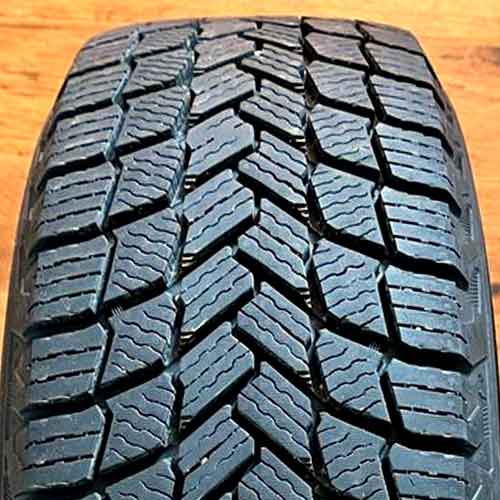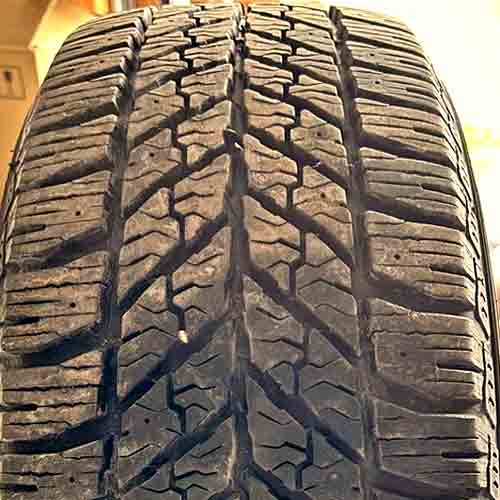Both Michelin X Ice Snow and Goodyear Ultra Grip Winter are esteemed performers in the winter tire segment, each bringing unique attributes in traction, tire life, and comfort, offering a spectrum of options to match varying driver preferences and road conditions. Though, still, let’s see which out of them, is a more suitable pick for you.

Table of Contents
Key Takeaway
- Noise Generation: The Michelin X Ice Snow produces less noise due to fewer air cavities and variable pitch technology that helps cancel out noise frequencies.
- Wet Traction: The X-Ice Snow has better traction on wet surfaces, offering superior grip and hydroplaning resistance, thanks to its advanced rubber compound and multi-angled sipe design.
- Vibration Absorption: The Goodyear Ultra Grip Winter leads here, due to a more pliable rubber compound, offering a smoother ride.
- Ice Performance: The X-Ice provides superior performance on icy surfaces due to its unique tread design, aggressive siping pattern, and angled incisions.
- Dry Traction: Michelin’s tire has better dry performance, offering superior directional grip and handling due to its central tread region and closely packed voids.
- Tread Life: The Michelin X-Ice Snow offers a longer tread life due to lower weight and reduced rolling resistance.
- Snow Performance: The Goodyear Ultra Grip Winter is slightly more efficient in fluffy snow due to its tread design which encourages snow-to-snow contact. The Michelin X-Ice Snow, with a less aggressive design, falls behind in heavier snow conditions.
- Fuel Usage: The Michelin’s tire is more fuel-efficient due to a stable lug design and stiffer rubber composition that reduces rolling resistance.
Noise Generation
The overall quality of a driving experience can be significantly affected by tire noise, which mainly stems from air particles colliding with the tire tread.

As the tire rolls, air basically gets pumped if you will, in and out of the tread, and so how voided up the tread design is, tells you about the noise levels.
That’s why in this regard, the Michelin X Ice Snow takes the show, with a reduced number of air cavities for noise to travel through.
Where its tread structure don’t allow too much noise production in the first place, it further gets quieter with its superior variable pitch technology, (which generates tones in a way, so that they could cancel out each other frequencies).
The Goodyear Ultra Grip on the other side, is missing with that, and the tire’s softer compound produces greater in-groove resonance values as well.
Review X-Ice Snow in greater details: https://snowytires.com/michelin-x-ice-snow-review/
Wet Traction
A tire’s efficiency on wet surfaces is largely determined by its tread design and rubber composition. And the Michelin X-Ice Snow leads the pack in this category, yielding superior grip, handling, and resistance to hydroplaning.

Its advanced rubber compound disperses water remarkably well, significantly enhancing traction on wet surfaces, and its multi-angled sipe design further adds to that.
So in comparison, you get 5 feet shorter braking distances and 2 seconds shorter handling lap times (on average).
Moreover, its curving arms results in better float speeds on both curved and straight aqua tests too.
Vibration Absorption
Tires effectively serve as secondary suspension systems for vehicles, absorbing the initial impacts, coming form the road irregularities.
And in this regard, the Goodyear Ultra Grip Winter takes the cake, as it features a more pliable rubber compound, where lugs are also made flexible.
So any impact the tread faces, easily gets translated in to the molding of the lugs, instead of creating a jittery ride.
The Michelin X Ice Snow on the other hand, although provides decent steering response with its firmer rubber, it lacks here, due to its reduced abilities to settle down the vibrations of the surface.
Though its stiffer tread really helps when it comes to overall tread life performance.
Ice Performance
Among tires specifically engineered for icy conditions, the Michelin X-Ice Snow shines remarkably.
Its superior performance stems mainly from a unique tread design incorporating multi-directional snow vices and angled incisions.
This design, coupled with an aggressive siping pattern, significantly reduces braking distances and improves handling responsiveness.
In contrast, the Goodyear Ultra Grip Winter struggles with its less pronounced overall siping, and biting abilities.
However, it partially compensates with studdable lugs that improve traction in extreme icy conditions.
Dry Traction
In dry conditions, the Michelin X-Ice Snow excels in both directional grip and handling, the primary constituents of overall dry performance.
The tire’s grip is mainly driven by the central tread region where it showcases a continuous, streamlined rib that maintains consistent contact with the road, enabling more efficient braking and acceleration.
And regarding handling, which depends largely on the tire’s shoulders, the X-Ice Snow employs closely packed voids to maximize rubber-to-road contact during cornering maneuvers.
In contrast, the Goodyear Ultra Grip Winter under performs with broader grooves and softer tread compound that cause greater lug movement during cornering, thereby compromising steering feedback and overall handling.
Tread Life
The lifespan of a tire’s tread largely depends on its rolling resistance, a factor heavily influenced by the tire’s weight and tread design. In this respect, the lighter Michelin X-Ice Snow outperforms its competition, boasting greater tread life. Its reduced weight alleviates pressure on the road, minimizing friction and slowing down tread wear.
The Goodyear Ultra Grip Winter, however, bears more weight over a smaller area due to larger tread gaps, which can accelerate wear and potentially shorten the tire’s lifespan. Therefore, the Michelin X-Ice Snow delivers a more enduring tread life.
Snow Performance
The Goodyear Ultra Grip Winter shows a slight edge in navigating through lighter, more fluffy snow, even though the tire can’t offer ample grip on packed up terrains, like ice.
This improved snow performance can be attributed to its uniquely structured tread pattern, featuring wider lugs that encourage snow-to-snow contact.
The broader voids within the tire’s tread design capture and hold snow particles more effectively, allowing the trapped snow to make better contact with the ground. This feature leverages the concept that snow sticks better to itself than to rubber, thereby enhancing traction.
On the other hand, the Michelin X-Ice Snow has a less aggressive, more compact tread design that’s not as effective at picking up snow, rendering it slightly less efficient in heavier snow conditions.
Fuel Usage
Fuel efficiency in tires is intimately connected to tread design and weight, as these aspects significantly impact rolling resistance, which in turn directly affects fuel consumption.
And considering both, it can be explained why Michelin Snow leads here.
The tire basically features a more stable lug design, with stiffer rubber composition. This basically leads to restricted lug/block movement, which then leads to lower energy expenditure.
On the other hand, with softer compound, the opposite happens on the Goodyear Winter. It’s lugs mold a lot more, as the tire maneuvers. So additional energy is required here, that could’ve used in to the rolling of the tire.
Summing Up
In conclusion, each tire brings its strengths to the table and is suited to different conditions and preferences.
The Michelin X-Ice Snow offers a quieter, more efficient ride with robust performance in various weather conditions.
In contrast, the Goodyear Ultra Grip Winter provides superior snow performance and smoother rides over rough terrains, while struggling in some areas like fuel efficiency and noise generation.
As always, the choice should be based on your specific needs and priorities, ensuring a safe, efficient, and comfortable drive.